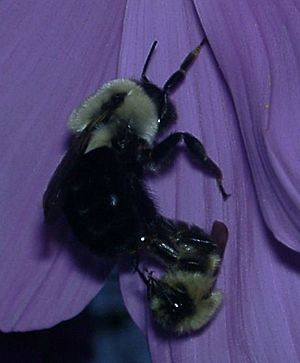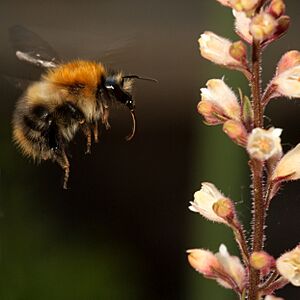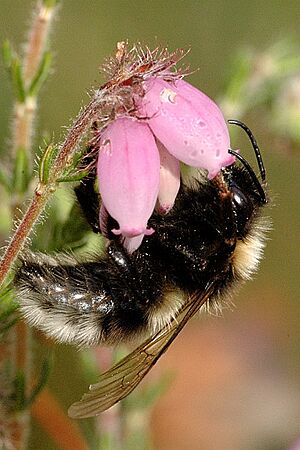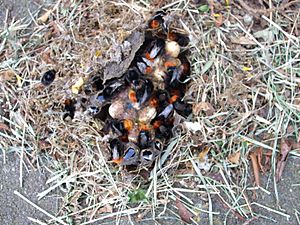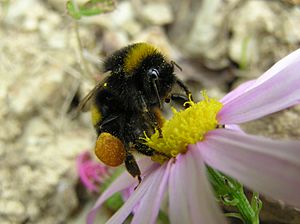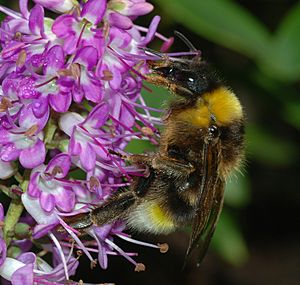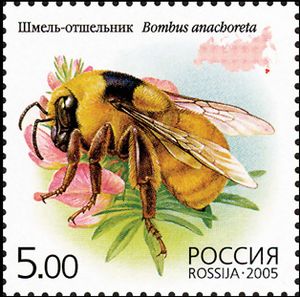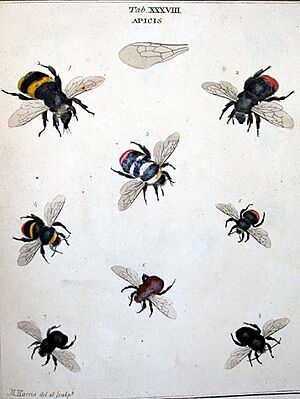Bumblebee facts for kids
Quick facts for kids Bombus |
|
|---|---|
 |
|
| Female Bombus terrestris cutting a flower to take its nectar |
|
| Scientific classification | |
| Kingdom: | |
| Phylum: | |
| Class: | |
| Order: | |
| Family: |
Apidae
|
| Subfamily: |
Apinae
|
| Tribe: |
Bombini
|
| Genus: |
Bombus
Latreille, 1802
|
| Species | |
|
More than 250 species in 15 subgenera. |
|
Bumblebees are a type of bee that often live in groups. They belong to the genus Bombus. There are about 250 different species of bumblebees. Most of them live in the Northern Hemisphere. You can also find them in New Zealand and Tasmania. They live almost everywhere in Europe and Asia.
Most bumblebees live in small groups called colonies. These colonies usually last for only one year. Bumblebees gather pollen to feed their young. They eat nectar themselves. They are very hairy, covered in soft hairs called a pile.
Like honey bees, most bumblebees have a social structure. This means they have a queen, workers, and drones (males). A typical colony has fewer than 50 members. However, some tropical species can have larger colonies.
Bumblebees have bright warning colours. These colours usually include black, red, yellow, and white. This is a common type of Müllerian mimicry found in bees and wasps. It tells predators to stay away because they can sting.
Contents
What do Bumblebees Look Like?
Bumblebees come in many different looks. But they are usually plump and very furry. They are bigger and have rounder bodies than honeybees. Many species have wide bands of colour. These patterns help tell different species apart.
Honeybees have short tongues. This means they mostly pollinate open flowers. Some bumblebee species have long tongues. They can reach nectar deep inside tube-shaped flowers. Compared to a honeybee, a bumblebee has a wider body. Its abdomen tip is also more rounded. Bumblebees have fewer stripes, or sometimes none. They usually have black fur on part of their body. Honeybees, however, have many stripes, including grey ones on their abdomen.
Bumblebees can be very different in size, even within the same species. For example, the largest British species, B. terrestris, has queens up to 22 mm long. Males are up to 16 mm long. Workers are between 11 and 17 mm long. The biggest bumblebee in the world is B. dahlbomii from Chile. It can be about 40 mm long. People describe it as a "monstrous fluffy ginger beast."
Where do Bumblebees Live?
Bumblebees usually live in temperate climates. You often find them in colder places, like higher latitudes and altitudes. A few species live in warm tropical lowlands. Some species, like B. polaris and B. alpinus, live in very cold areas. Other bees might not survive there. B. polaris lives in northern Ellesmere Island in the high Arctic. Another bumblebee, B. hyperboreus, lives there too. It takes over B. polaris nests. This is the farthest north any social insect lives.
Bumblebees can control their body temperature. They use sunlight, internal "shivering," and cooling from their abdomen. This helps them stay warm in cold places. Other bees have similar ways to control temperature. But bumblebees are best at it. They also adapt to high places by moving their wings more. Bumblebees live almost everywhere in the world. But they are not found in Australia (except Tasmania, where they were brought). In Africa, they only live north of the Sahara Desert.
How Bumblebees Live
Feeding Habits
A bumblebee's tongue is called a proboscis. It is long and hairy. It comes out from a special part of its mouth. The bee uses its tongue to lap up liquids. It dips its tongue into the liquid many times. The tip of the tongue acts like a suction cup. Nectar can also move up the tongue by capillary action. When not in use, the tongue folds under the bee's head.
Bumblebees learn which flowers are best for their tongue length. Bees with shorter tongues, like Bombus bifarius, might have trouble getting nectar. To solve this, they sometimes lick the back of flower parts. This still gives them a small reward.
Wax Production
Bumblebees make wax from glands on their abdomen. The wax comes out in small flakes. The queen uses wax when she starts a nest. Young workers also make wax. They scrape the wax off their abdomen with their legs. Then they shape it until it is soft. They use it to build honeypots and cover eggs. They also line empty cocoons to store things. Sometimes, they cover the outside of the nest with wax.
Bumblebee Colors
The bright, furry coat of a bumblebee is a warning signal. Female bumblebees can give a painful sting. Their warning colours can be all black, or bright yellow, red, orange, white, and pink. Many flies, like hoverflies and robber flies, look like bumblebees. This is called Batesian mimicry. It helps them fool predators.
Many Bombus species, including cuckoo bumblebees, use Müllerian mimicry. This means different bumblebees in an area look alike. So, a young predator only needs to learn to avoid one type. For example, in California, some bumblebees are mostly black. Others are banded black and yellow. This mimicry helps all the bees in the group survive.
Controlling Body Temperature
Bumblebees are active even when it's cold. Honeybees stay in their hives in such conditions. Bumblebees can easily get warm from even weak sunshine. Their thick fur acts like insulation. It keeps them warm in cold weather. Species from cold places have longer fur, which provides better insulation.
The muscles used for flying are in the thorax. These muscles need to be at least 30°C (86°F) for the bee to fly. Bumblebees can warm up these muscles by shivering. It takes about five minutes for the muscles to reach this temperature when the air is 13°C (55°F). Bumblebees have the lowest "chill-coma temperature" among bees. This is the temperature where flight muscles stop working. This allows them to fly in colder temperatures than other bees.
Communication and Learning
Bumblebees do not have ears. We don't know if they can hear well. But they can feel vibrations from sounds moving through wood or other things.
Bumblebees do not do the "bee dances" that honeybees use. Honeybees use these dances to tell others where food is. Instead, when a bumblebee finds good food, it returns to the nest. It runs around excitedly for a few minutes. Then it goes out to find more food. These bees might be communicating with buzzing sounds from their wings. This could encourage other bees to go foraging. The amount of food in the colony also affects foraging. If there's little honey, or good food is added, bees are more likely to go out.
Bumblebees can also learn from each other. In one study, bees learned to move objects to get a reward. Bees that watched another bee do the task learned much better. This shows how important social information is for them. The bees didn't copy exactly. They seemed to try to achieve the same goal as the other bee.
Reproduction and Life Cycle
The size of a bumblebee nest depends on the species. Most colonies have between 50 and 400 bees. Some can be as small as 20 or as large as 1700. These nests are much smaller than honeybee hives, which can hold about 50,000 bees. Many species build nests underground. They might use old rodent burrows or sheltered spots. They avoid sunny places to prevent overheating. Other species build nests above ground, in thick grass or tree holes.
A bumblebee nest is not neatly organized like a honeybee's hexagonal comb. Their cells are clustered together in a messy way. Workers remove dead bees or larvae from the nest. They put them outside the entrance. This helps prevent diseases. Nests in temperate regions only last for one season. They do not survive the winter.
In early spring, the queen comes out of a resting state called diapause. She finds a good place to start her colony. She builds wax cells and lays her eggs. These eggs were fertilized the year before. The eggs hatch into female workers. Over time, the queen builds up the colony. Workers feed the young and do other jobs, like honeybee workers.
In temperate areas, young queens leave the nest in the autumn. They mate, often more than once, with males called drones. The drones are forced out of the colony. The drones and workers die when the weather gets cold. The young queens eat a lot to store fat for winter. They survive the winter in a resting state, usually underground. They stay there until the weather warms up in spring. Many bumblebee species follow this yearly cycle.
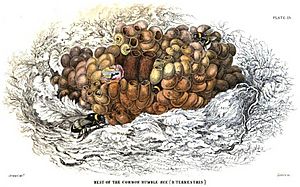
In fertilized queens, the ovaries only become active when the queen starts laying eggs. An egg goes to a chamber where sperm is stored. The queen can choose to fertilize the egg or not. Unfertilized eggs become haploid males. Fertilized eggs become diploid females and new queens. Female worker bees have hormones that stop their ovaries from developing. This keeps the queen in charge.
To grow, larvae need both nectar for carbohydrates and pollen for protein. Bumblebees feed nectar to larvae by making a small hole in the cell. Then they spit nectar into it. Larvae get pollen in two ways. Some bumblebees make pollen pockets at the base of the cells. The larvae feed themselves from these. Other bumblebees store pollen in separate wax pots and feed it to the larvae.

After the first or second group of young bees appears, workers take over foraging. The queen spends most of her time laying eggs and caring for larvae. The colony grows bigger. Eventually, it starts to produce males and new queens.
Unlike honeybee workers, bumblebee workers can lay eggs. They lay unfertilized eggs that become male bumblebees. Only fertilized queens can lay eggs that become workers and new queens. In a young colony, the queen stops workers from laying eggs. She uses physical actions and special chemicals called pheromones. Workers usually eat almost all eggs laid by other workers. So, the queen is usually the mother of all the first males. Later in the season, workers start laying male eggs. This happens when the queen's power to stop them weakens. Because workers and the queen compete to reproduce, bumblebees are called "primitively eusocial."
Most bumblebees have one queen in their colony. But some species, like Bombus atratus, can have many queens in one nest for part of their life.
How Bumblebees Find Food
Bumblebees usually visit flowers that are good for bee pollination syndrome. These flower patches can be up to 1-2 km from their colony. They tend to visit the same flower patches every day. They do this as long as they find nectar and pollen there. This habit is called flower constancy. When foraging, bumblebees can fly very fast, up to 15 km/h.
Bumblebees use colors and the layout of flowers to learn where to find food. They can also sense electric fields on flowers. These fields are caused by atmospheric electricity. They take a while to fade away. Bumblebees use this to know if another bee has recently visited a flower. After landing on a flower, they use their long tongues to get nectar. They store it in their crop.
Many bumblebee species also "rob nectar." Instead of going into the flower normally, they bite through the base of the flower. This lets them get nectar without transferring pollen.
Bumblebees collect pollen from flowers either on purpose or by accident. When they enter a flower, pollen sticks to their body hairs. Queens and workers then brush this pollen into special "pollen baskets" on their back legs. These baskets can hold millions of pollen grains. Male bumblebees do not have pollen baskets and do not collect pollen. Bumblebees can also do buzz pollination. They shake pollen off flowers by vibrating their flight muscles.
After visiting a flower, a bumblebee leaves a scent mark on it. This scent stops other bumblebees from visiting that flower until the scent fades. This scent is a general chemical mix that bumblebees leave in different places. They learn to use this scent to find good and bad flowers. They might even know who else visited a flower. Bumblebees rely more on this scent when it takes longer to get nectar from a flower.
Once they collect nectar and pollen, female workers return to the nest. They put the food into brood cells or wax cells for storage. Unlike honeybees, bumblebees only store a few days' worth of food. This makes them more vulnerable to food shortages. Male bumblebees only collect nectar to feed themselves. They might visit different flowers than the workers because their food needs are different.
Cuckoo Bumblebees
Bumblebees from the subgenus Psithyrus are called 'cuckoo bumblebees'. They are brood parasites. This means they lay their eggs in other bumblebee colonies. They have lost the ability to collect pollen. Before finding a host colony, a female Psithyrus bee feeds directly from flowers. Once she gets into a host colony, she kills or controls the host queen. She uses chemicals and attacks to make the host workers feed her and her young. Cuckoo bumblebees often kill the host queen. This helps them produce more offspring. But some species, like B. bohemicus, do better if they leave the host queen alive.
Female Psithyrus bees have special body parts for fighting. They have bigger jaws, tough skin, and a larger venom sac. These help them take over a nest. After hatching, the male and female Psithyrus bees spread out and mate. The males do not survive the winter. But like other bumblebee queens, Psithyrus females find places to spend the winter and rest after mating. They usually come out of hibernation later than their host species. Each cuckoo bee species has a specific host species. They often look like their host. For example, in a study of B. terrestris and its parasite B. (Psithyrus) vestalis, about 42% of host nests had lost their fight against the parasite.
Sting
Queen and worker bumblebees can sting. Unlike honeybees, a bumblebee's sting does not have barbs. This means the bee can sting many times without hurting itself. The sting is not left in the wound. Bumblebee species are usually not aggressive. But they might sting to defend their nest or if they are hurt. Female cuckoo bumblebees aggressively attack host colony members. They sting the host queen. But they usually ignore other animals unless disturbed.
Who Eats Bumblebees?
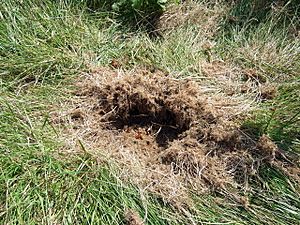
Even though bumblebees can sting, some animals eat them. Badgers might dig up nests and eat all the bees inside. In North America, robber flies and beewolves hunt adult bumblebees. In Europe, birds like bee-eaters and shrikes catch flying bumblebees. Smaller birds like great tits also learn to catch them. Camouflaged crab spiders catch them when they visit flowers.
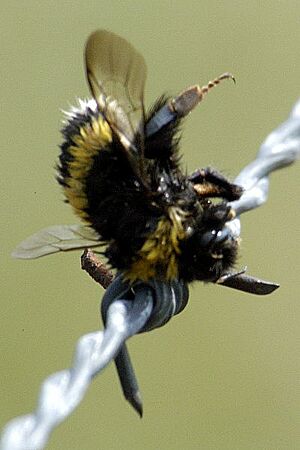
The great grey shrike can spot flying bumblebees up to 100 meters away. Once caught, the shrike removes the sting. It does this by squeezing the bee with its mouth and wiping its abdomen on a branch. The European honey buzzard follows flying bees back to their nest. It digs out the nest with its feet. Then it eats the larvae, pupae, and adult bees it finds.
Bumblebees can also get sick from tiny creatures. These include mites, protozoans, and microsporidians. The tree bumblebee, B. hypnorum, has spread in the United Kingdom. This is despite having many nematodes that usually stop queens from starting colonies. A virus called Deformed wing virus has been found in 11% of bumblebees in Great Britain.
Bumblebees and Humans
Farming Use
Bumblebees are very important pollinators. They help both crops and wildflowers grow. Bumblebees do not store a lot of honey because their colonies don't last through winter. So, they are not used to produce honey.
More and more, bumblebees are raised for farming. They are used as pollinators. For example, they can pollinate plants like tomatoes in greenhouses using buzz pollination. Other pollinators cannot do this. Commercial production of bumblebees started in 1987. Today, over a million nests are grown each year in Europe. Turkey is a big producer.
Bumblebees are native to the Northern Hemisphere. In the 1800s, red clover was brought to New Zealand. But it had no local pollinators. So, clover seeds had to be imported every year. To fix this, four species of bumblebees from the United Kingdom were brought to New Zealand. This helped red clover grow from local seeds. Bumblebees are also raised to pollinate tomatoes in greenhouses. The buff-tailed bumblebee from New Zealand naturally spread to Tasmania in 1992.
There are some worries about the global trade in bumblebee colonies. Bumblebees can escape and start living in new places. This can harm native pollinators. Because of this, some places like China and Japan are using more native pollinators. Also, there is growing evidence that farmed bumblebees can carry diseases. These diseases can harm wild bumblebees and honeybees.
In Canada and Sweden, growing different crops together helps bumblebees. This also leads to higher crop yields than growing just one crop.
Why Bumblebees are Declining
Bumblebee species are decreasing in Europe, North America, and Asia. This is due to several reasons. One reason is changes in land use, which reduces their food plants. In North America, diseases might be having a strong negative effect.
A big impact on bumblebees came from modern farming. This sped up during World War II. Small farms used horses, which ate clover and hay. These plants were always grown on farms. Little artificial fertilizer was used. So, farms had lots of flowering clover and flower-rich meadows. This was good for bumblebees.
But modern farming removed the need for horses and most of the clover. Artificial fertilizers made taller grasses grow. These grasses outcompeted meadow flowers. Most of the flowers, and the bumblebees that fed on them, disappeared from Britain by the early 1980s. The last native British short-haired bumblebee was seen in 1988.
The increase in pesticides and fertilizers has harmed bumblebees. Bees are exposed to chemicals in two ways. They eat nectar treated with pesticide. Or they touch treated plants and flowers. The Bombus hortorum species has been affected by pesticides. Their young develop less, and their memory is harmed. Pesticides also negatively affect colony growth and size.
The European Food Safety Authority found that three pesticides were very risky for bees. These pesticides are called neonicotinoids. Studies on B. terrestris showed that realistic levels of one pesticide greatly reduced growth. It also cut the production of new queens by 85%. This means a big negative effect on wild bumblebee populations. Low levels of neonicotinoids can reduce colony size by 55%. They can also cause problems in bumblebee brains. This is alarming because bumblebees need their intelligence for daily tasks. Another study showed that neonicotinoid pesticides can affect how well bumblebees find food and pollinate. Bees affected by the pesticide collected more pollen. But they took longer to do it.
Out of 19 native bumblebee species in Britain, three have disappeared. Eight are in serious decline. Only six are still common. Similar declines are seen in Ireland. Four species are endangered, and two are vulnerable. A drop in bumblebee numbers could greatly change the countryside. This is because many plants would not be pollinated enough.
Some North American bumblebees are also disappearing. One species, Bombus franklini, might even be extinct. In South America, Bombus bellicosus disappeared from its northern range. This was likely due to intense land use and climate change.
Helping Bumblebees
In 2006, a bumblebee researcher started the Bumblebee Conservation Trust. Its goal is to stop any UK bumblebees from going extinct. In 2009 and 2010, the Trust tried to bring back the short-haired bumblebee. This species had disappeared from Britain. They used bees from New Zealand, where they were introduced a century ago. Since 2011, the Trust has brought short-haired bumblebee queens from Sweden to England. They put them in restored flower-rich meadows. The queens were checked for mites and diseases. Special farming programs have created over 800 hectares of new flower habitat for the bees. By 2013, workers of the species were found. This proved that nests had been made. The restored habitat has also helped five other important bumblebee species recover.
The world's first bumblebee sanctuary opened in Scotland in 2008. In 2011, the Natural History Museum helped create a group to assess bumblebee threats worldwide.
Bumblebee conservation is still new in many parts of the world. But people are realizing how important they are for pollinating crops. Efforts are being made to manage farmland better. Planting strips of wildflowers can help wild bee populations. In New Zealand, bee nesting boxes have worked well. This might be because there are few burrowing animals there to provide natural nesting sites.
The Myth About Bumblebee Flight
There's a popular story from the 20th century. It says that the rules of aerodynamics prove bumblebees cannot fly. The story claims that a bumblebee's wings are too small for its body weight.
One story says an unnamed Swiss scientist at a dinner party did some quick math. He supposedly joked that, according to the equations, bumblebees couldn't fly. This claim is hard to trace exactly. Some say it came from a 1934 French book about insect flight. The authors applied equations for air resistance to insects. They found that their flight seemed impossible. But they noted that calculations don't always match reality.
The calculations that "proved" bumblebees couldn't fly were too simple. They didn't consider how wings move in a complex way. More advanced studies show that bumblebees can fly. Their wings create a special air swirl that gives them enough lift.
Also, a biologist named John Maynard Smith pointed out that at the small scale of insects, air acts differently. It's more like a thick liquid. This means even small wings can move a lot of air. This greatly reduces the power needed for flight.
Bumblebees in Culture
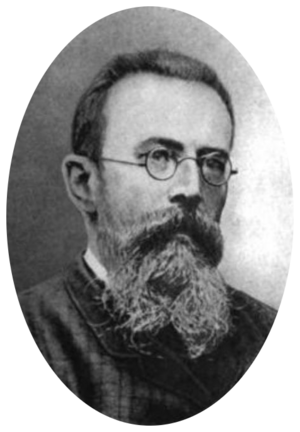
The famous orchestral piece Flight of the Bumblebee was written around 1900 by Nikolai Rimsky-Korsakov. It's from his opera The Tale of Tsar Saltan. The music describes Prince Guidon turning into a bumblebee to fly and visit his father.
In 1599, a book called Caltha Poetarum: Or The Bumble Bee was published. It was one of nine books banned by the Archbishop of Canterbury.
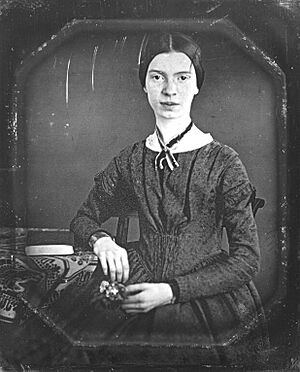
The poet Emily Dickinson wrote a poem about a bumblebee. It was a parody of a well-known poem about honeybees.
The entomologist Otto Plath wrote Bumblebees and Their Ways in 1934. His daughter, the poet Sylvia Plath, later wrote poems about bees.
The scientist and artist Moses Harris painted detailed drawings of bumblebees. These were in his book An Exposition of English Insects (1776–80).
Bumblebees appear as characters in children's books. The name Dumbledore in the Harry Potter series is an old word for bumblebee. J. K. Rowling said the name suited the headmaster. She imagined him humming to himself. Many children's books feature bumblebees. These include Bumble the Bee and Bertie Bumble Bee.
Bumblebee is a popular character in the Transformers series. His name comes from his black and yellow car paint job. This directly refers to the bee's black and yellow stripes. "Bumblebee" is also a type of racing stripe on cars. It wraps around the front grill. You often see it on Chevrolet Camaros.
Images for kids
-
Beatrix Potter's 1910 story The Tale of Mrs. Tittlemouse features a "bumble bee" called Babbity Bumble.
-
The Russian composer Nikolai Rimsky-Korsakov wrote the Flight of the Bumblebee around 1900.
-
Emily Dickinson wrote "The Bumble-Bee's Religion" (1881).
See also
 In Spanish: Bombus para niños
In Spanish: Bombus para niños



